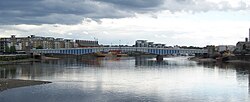
Back جسر وندسوورث Arabic كوبرى واندسوورث ARZ Wandsworth Bridge Czech Wandsworth Bridge German Puente de Wandsworth Spanish Wandsworth Bridge French Wandsworth Bridge Italian Wandsworth Bridge NB Уондсуэртский мост Russian Wandsworth Bridge Slovak
Wandsworth Bridge | |
|---|---|
 | |
| Coordinates | 51°27′54″N 0°11′17″W / 51.46500°N 0.18806°W |
| Carries | A217 road |
| Crosses | River Thames |
| Locale | London, England |
| Maintained by | Wandsworth London Borough Council |
| Preceded by | Fulham Railway Bridge |
| Followed by | Battersea Railway Bridge |
| Characteristics | |
| Design | Cantilever bridge |
| Material | Steel |
| Total length | 650 feet (200 m) |
| Width | 60 feet (18 m) |
| No. of spans | 3 |
| Clearance below | 39 feet (11.9 m) at lowest astronomical tide[1] |
| History | |
| Designer | Thomas Peirson Frank |
| Opened | 26 September 1873 (first bridge) 25 September 1940 (second bridge) |
| Statistics | |
| Daily traffic | 53,299 vehicles (2004)[2] |
| Location | |
 | |
Wandsworth Bridge crosses the River Thames in west London. It carries the A217 road between the area of Battersea, near Wandsworth Town Station, in the London Borough of Wandsworth on the south of the river, and the areas of Sands End and Parsons Green, in the London Borough of Hammersmith and Fulham, on the north side.
The first bridge on the site was a toll bridge built by Julian Tolmé in 1873, in the expectation that the western terminus of the Hammersmith and City Railway would shortly be built on the north bank, leading to a sharp increase in the number of people wanting to cross the river at this point. The railway terminus was not built, and problems with drainage on the approach road made access to the bridge difficult for vehicles. Wandsworth Bridge was commercially unsuccessful, and in 1880 it was taken into public ownership and made toll-free. Tolmé's bridge was narrow and too weak to carry buses, and in 1926 a Royal Commission recommended its replacement.
In 1937 Tolmé's bridge was demolished. The present bridge, an unadorned steel cantilever bridge designed by Sir Thomas Peirson Frank, was opened in 1940. At the time of its opening it was painted in dull shades of blue as camouflage against air raids, a colour scheme it retains. Although Wandsworth Bridge is one of the busiest bridges in London, carrying over 50,000 vehicles daily, it has been described as "probably the least noteworthy bridge in London".
- ^ Cite error: The named reference
Thames Bridges Heightswas invoked but never defined (see the help page). - ^ Cookson 2006, p. 316
© MMXXIII Rich X Search. We shall prevail. All rights reserved. Rich X Search